
The Battle of Chosin Reservoir, also known as the Chosin Reservoir Campaign or the Battle of Jangjin Lake was an important battle in the Korean War. The name "Chosin" is derived from the Japanese pronunciation "Chōshin", instead of the Korean pronunciation.
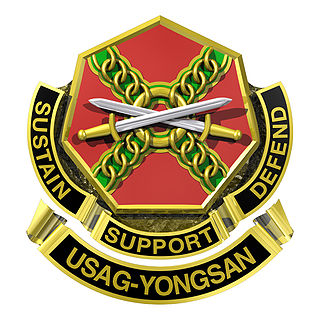
Yongsan Garrison, meaning "dragon hill," is an area roughly two-thirds the size of New York's Central Park located in the Yongsan District of central Seoul, South Korea. The site served as the headquarters for U.S. military forces stationed in South Korea, known as United States Forces Korea (USFK), and as United States Army Garrison Yongsan (USAG-Yongsan) until 2018, under the supervision of the U.S. Army's Installation Management Command Pacific Region. From 1910 to 1945 it served as headquarters for the Imperial Japanese Army. The USFK headquarters relocated to the new $11 billion Camp Humphreys in Pyeongtaek south of Seoul in 2018, as part of the Yongsan Relocation Plan. By the end of 2019, more than 20,000 U.S. troops and family members will have been relocated to the new Camp Humphreys facility south of Seoul. While most of the land will be returned to the South Korean government, the U.S. will retain a small portion of land in order to keep open the Dragon Hill Lodge military resort hotel and for a future site to relocate the U.S. Embassy in Seoul. Korean officials are still debating the future use of the land being returned, with some calling for a large park and others calling for more affordable housing.

Osan is a city in Gyeonggi Province, South Korea, approximately 35 km (22 mi) south of Seoul. The population of the city is around 200,000. The local economy is supported by a mix of agricultural and industrial enterprises.

The American Forces Network (AFN) is the broadcast service operated by the United States Armed Forces' American Forces Radio and Television Service for its entertainment and command internal information networks worldwide. The AFN worldwide radio and television broadcast network serves American servicemembers, Department of Defense and other U.S. government civilians and their families stationed at bases overseas, as well as U.S. Navy ships at sea. AFN broadcasts popular American radio and television programs from the major U.S. networks. It is sometimes referred to as the Armed Forces Network. AFRTS, American Forces Network and AFN are registered trademarks of the U.S. Department of Defense. It is based at Fort George G. Meade in Maryland and is part of the Defense Media Activity.

The Eighth Army a U.S. field army which is the commanding formation of all United States Army forces in South Korea. It commands U.S. and South Korean units and is headquartered at the United States Army Garrison-Humphreys, in the Anjeong-ri of Pyeongtaek, South Korea. It is the only field army in the U.S. Army
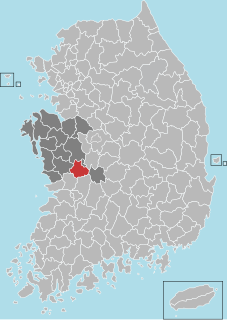
Nonsan is a city in South Chungcheong Province, South Korea. It is located at 36°12′N127°5′E. Nonsan is also called Nolmoi, meaning dusk(y) or yellow mountain. The origin of Nonsan's geographical names is said to have come from the small garden " Nonmoi, " which rises in the middle of farming fields, where rice paddies and mountain are said to reflect geographical features.
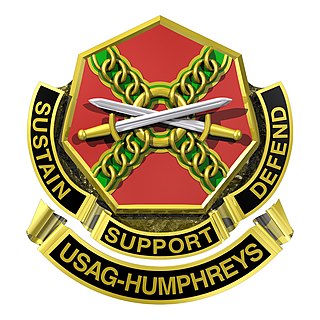
Camp Humphreys, also known as United States Army Garrison-Humphreys (USAG-H), is a United States Army garrison located near Anjeong-ri and Pyeongtaek metropolitan areas in South Korea. Camp Humphreys is home to Desiderio Army Airfield, the busiest U.S. Army airfield in Asia, with an 8,124 feet (2,476 m) runway. In addition to the airfield, there are several U.S. Army direct support, transportation, and tactical units located there, including the Combat Aviation Brigade, 2nd Infantry Division. The garrison has an area of 3,454 acres (1,398 ha) and cost US$11 billion. Camp Humphreys is the largest U.S. overseas military base, housing some 500 buildings and amenities.
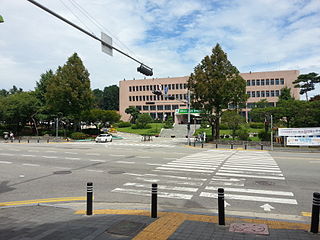
Songtan is an area in the northern end of Pyeongtaek, Gyeonggido, South Korea. Songtan achieved city status in its own right in 1981, five years earlier than Pyeongtaek, but merged, along with Pyeongtaek County, into Pyeongtaek City in May 1995. Most residents still consider it to have an identity separate from the rest of Pyeongtaek City. To appease some discontent at the merger Pyeongtaek city officials decided to keep the Songtan City Hall intact and convert it into a branch office of the Pyeongtak City Hall, as shown in the picture above, where Songtan residents can still go for city provided services. At consolidation, Songtan had over 110,000 residents, slightly less than the population of pre-consolidation Pyeongtaek City. The district has an administrative office which formerly served as Songtan City Hall. Songtan's best known feature is Osan Air Base, a United States Air Force base which spawned the growth of the area and is a major factor in the district's economy.

United States Forces Korea (USFK) is a sub-unified command of United States Indo-Pacific Command (USINDOPACOM). USFK is the joint headquarters through which U.S. combat forces would be sent to the South Korea/US (ROK/U.S.) Combined Forces Command's (CFC) fighting components — the combined ground, air, naval, marine and special operations forces component commands. Major USFK elements include Eighth U.S. Army (EUSA), U.S. Air Forces Korea, U.S. Naval Forces Korea (CNFK), U.S. Marine Forces Korea (MARFORK) and Special Operations Command Korea (SOCKOR). It was established on July 1, 1957.

Camp Red Cloud (CRC) is a United States Army camp located in the city of Uijeongbu, between Seoul and the Korean Demilitarized Zone (DMZ). CRC is being returned to the Korean government. The installation was renamed after Medal of Honor recipient Corporal Mitchell Red Cloud Jr. on Armed Forces Day, May 18, 1957 from its earlier name of Camp Jackson.

Camp Hovey is a United States Army military base in Dongducheon, Gyeonggi Province, South Korea. It was named after Master Sergeant Howard Hovey who was killed in action at Pork Chop Hill during the Korean War. The camp is adjacent to the larger Camp Casey connected by a road known as "Hovey Cut". The nearest city to Camp Hovey is Dongducheon, which is roughly 15 miles (24 km) from the Korean Demilitarized Zone (DMZ). There is a south gate into Camp Hovey from Gwangam-dong village, but not as many things to do as outside Camp Casey's main gate.

The Korean People's Army Air and Anti-Air Force is the unified military aviation force of North Korea. It is the second largest branch of the Korean People's Army comprising an estimated 110,000 members. It possesses 940 aircraft of different types, mostly of old Soviet and Chinese origin. Its primary task is to defend North Korean airspace.
Camp Stanley is a former U.S. Army military camp located just east of the city of Uijeongbu, South Korea. The camp is part of the Red Cloud Garrison which is composed of Army installations near the Korean Demilitarized Zone (DMZ).
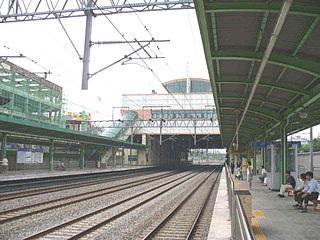
Songtan Station is a ground level metro station in Songtan, a district of Pyeongtaek in Gyeonggi Province, South Korea. The station is on Line 1 of the Seoul Metropolitan Subway, which runs from Soyosan in Dongducheon to Cheonan in Chungcheongnam-do. The line also serves Osan, Suwon, and Seoul.

Seojeong-ri Station is a station in Seojeong-dong, Pyeongtaek, South Korea. Mugunghwa-ho trains running on the Gyeongbu Line stop here. Additionally, services on Seoul Subway Line 1 have been calling at this station since 2005. Its secondary name is Kookje University.

The US Army Garrison Camp Long is located near Wonju, South Korea. This camp was named in honor of Sergeant Charles R. Long of the US Army, who received the Medal of Honor for his actions nearby in 1951 during the Korean War. Sergeant Long was acting as a forward observer in Company M of the 38th Infantry Regiment, 2nd Infantry Division when he was killed in action.

Camp Walker is a U.S. military base in Daegu, South Korea. Camp Walker was named in 1951 after General Walton Walker, commander of the Eighth Army who was killed in a jeep crash in December 1950 during the Korean War. Camp Walker, Camp Henry, and Camp George are the three U.S. military bases in Daegu, part of the U.S. Army Garrison Daegu. Camp Walker spans 94 acres (0.38 km2) and contains military family housing for about 100 military and civilian families. Also on Camp Walker are Daegu Middle High School, a DoDEA school serving 7th to 12th graders; the main Exchange and DeCA Commissary; the Camp Walker Army Lodge; the Evergreen Golf Course; Kelly Gym and Athletic Field; and several Family and Morale, Welfare and Recreation (FMWR) clubs.
Camp Market is an installation of the United States Army, based on USAG Yongsan and it is situated in Bupyeong District, Incheon, South Korea.It is around halfway between Yongsan Garrison and the Port of Incheon, 30 miles to the west. The camp is not usually operated by U.S. Army divisions, except the 55th Military Police Company, which settled permanently in this camp. Unlike most Eight Army camps in South Korea, it is a supply depot. It is operated by civilian forces, mostly Korean nationals.It is now used as an AAFES Bakery and AAFES Distribution Center.





















